TOYOTA CAMRY HYBRID 2023 Workshop Manual
Manufacturer: TOYOTA, Model Year: 2023, Model line: CAMRY HYBRID, Model: TOYOTA CAMRY HYBRID 2023Pages: 624, PDF Size: 10.51 MB
Page 51 of 624
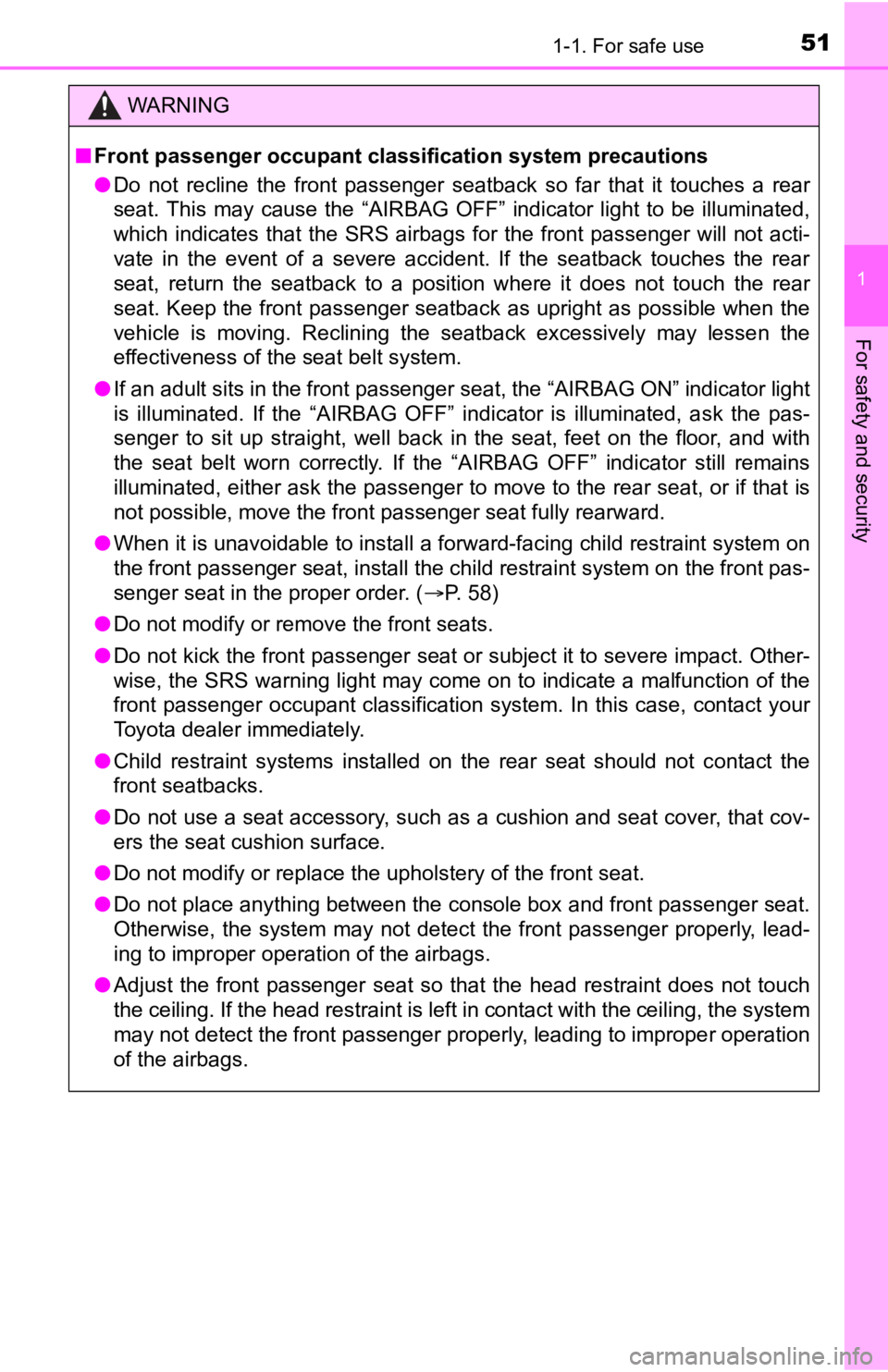
511-1. For safe use
1
For safety and security
WARNING
■Front passenger occupant classification system precautions
● Do not recline the front passenger seatback so far that it touches a rear
seat. This may cause the “AIRBAG OFF” indicator light to be ill uminated,
which indicates that the SRS airbags for the front passenger wi ll not acti-
vate in the event of a severe accident. If the seatback touches the rear
seat, return the seatback to a position where it does not touch the rear
seat. Keep the front passenger seatback as upright as possible when the
vehicle is moving. Reclining the seatback excessively may lesse n the
effectiveness of the seat belt system.
● If an adult sits in the front passenger seat, the “AIRBAG ON” indicator light
is illuminated. If the “AIRBAG OFF” indicator is illuminated, ask the pas-
senger to sit up straight, well back in the seat, feet on the floor, and with
the seat belt worn correctly. If the “AIRBAG OFF” indicator sti ll remains
illuminated, either ask the passenger to move to the rear seat, or if that is
not possible, move the front passenger seat fully rearward.
● When it is unavoidable to install a forward-facing child restraint system on
the front passenger seat, install the child restraint system on the front pas-
senger seat in the proper order. ( P. 58)
● Do not modify or remove the front seats.
● Do not kick the front passenger seat or subject it to severe im pact. Other-
wise, the SRS warning light may come on to indicate a malfunction of the
front passenger occupant classification system. In this case, contact your
Toyota dealer immediately.
● Child restraint systems installed on the rear seat should not contact the
front seatbacks.
● Do not use a seat accessory, such as a cushion and seat cover, that cov-
ers the seat cushion surface.
● Do not modify or replace the upholstery of the front seat.
● Do not place anything between the console box and front passenger seat.
Otherwise, the system may not detect the front passenger proper ly, lead-
ing to improper operation of the airbags.
● Adjust the front passenger seat so that the head restraint does not touch
the ceiling. If the head restraint is left in contact with the ceiling, the system
may not detect the front passenger properly, leading to imprope r operation
of the airbags.
Page 52 of 624
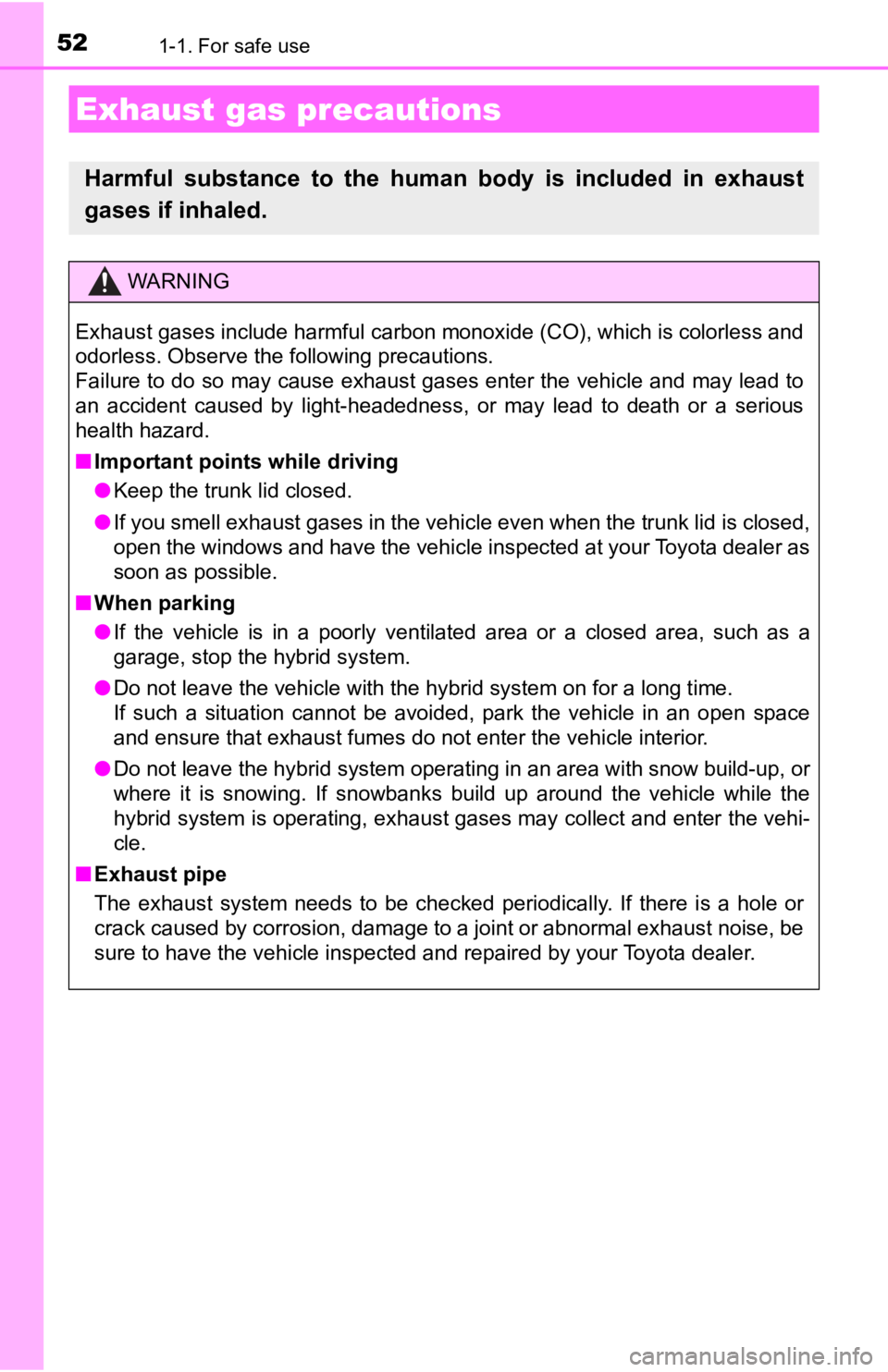
521-1. For safe use
Exhaust gas precautions
Harmful substance to the human body is included in exhaust
gases if inhaled.
WARNING
Exhaust gases include harmful carbon monoxide (CO), which is colorless and
odorless. Observe the following precautions.
Failure to do so may cause exhaust gases enter the vehicle and may lead to
an accident caused by light-headedness, or may lead to death or a serious
health hazard.
■ Important points while driving
● Keep the trunk lid closed.
● If you smell exhaust gases in the vehicle even when the trunk lid is closed,
open the windows and have the vehicle inspected at your Toyota dealer as
soon as possible.
■ When parking
● If the vehicle is in a poorly ventilated area or a closed area, such as a
garage, stop the hybrid system.
● Do not leave the vehicle with the hybrid system on for a long t ime.
If such a situation cannot be avoided, park the vehicle in an open space
and ensure that exhaust fumes do not enter the vehicle interior .
● Do not leave the hybrid system operating in an area with snow build-up, or
where it is snowing. If snowbanks build up around the vehicle w hile the
hybrid system is operating, exhaust gases may collect and enter the vehi-
cle.
■ Exhaust pipe
The exhaust system needs to be checked periodically. If there is a hole or
crack caused by corrosion, damage to a joint or abnormal exhaust noise, be
sure to have the vehicle inspected and repaired by your Toyota dealer.
Page 53 of 624
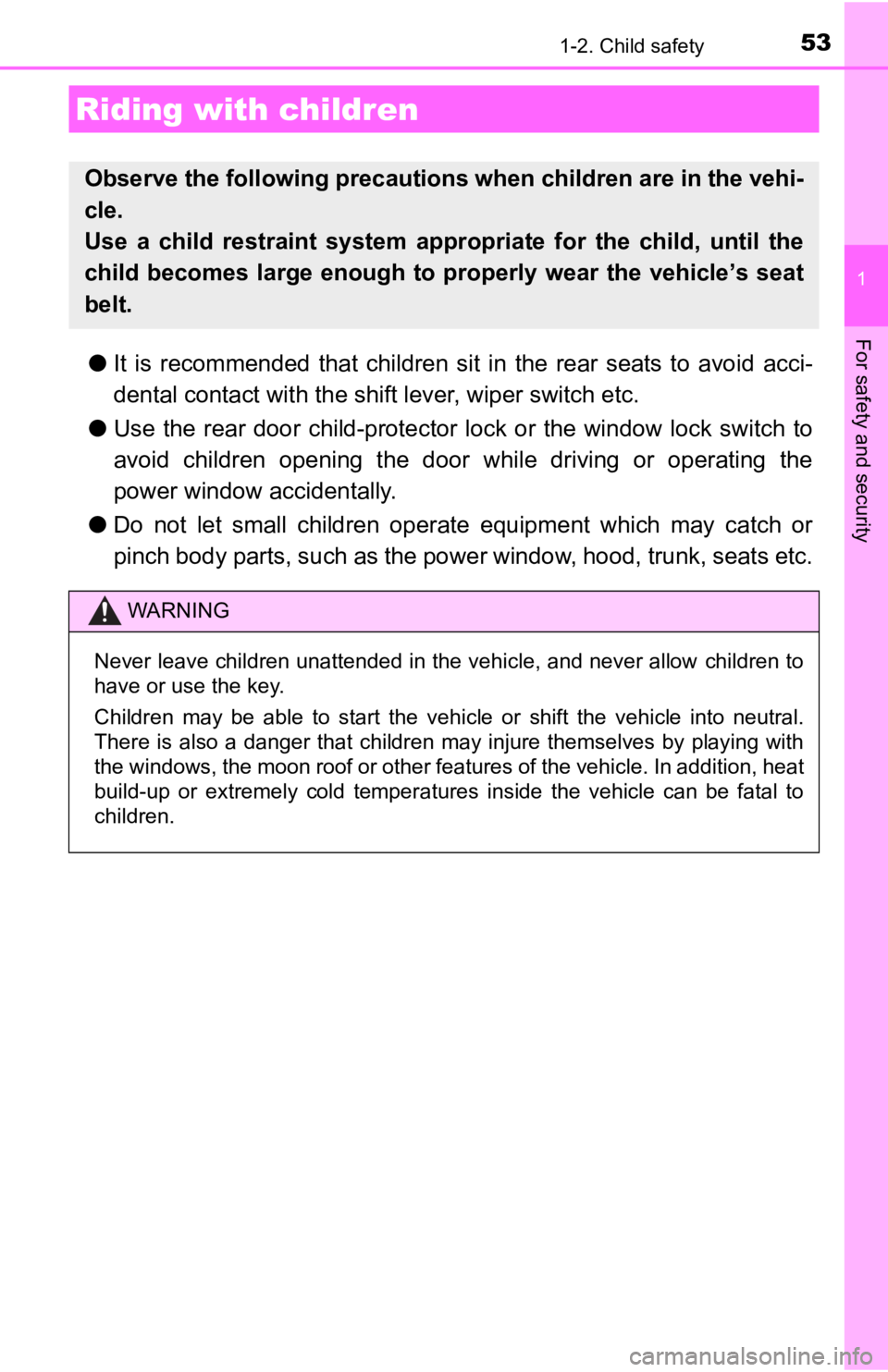
53
1
For safety and security
1-2. Child safety
●It is recommended that children sit in the rear seats to avoid acci-
dental contact wit h the shift lever, wiper switch etc.
● Use the rear door child-protector lock or the window lock switc h to
avoid children opening the door while driving or operating the
power window accidentally.
● Do not let small children operate equipment which may catch or
pinch body parts, such as the power window, hood, trunk, seats etc.
Riding with children
Observe the following precautions when children are in the vehi -
cle.
Use a child restraint system appropriate for the child, until the
child becomes large enough to properly wear the vehicle’s seat
belt.
WARNING
Never leave children unattended in the vehicle, and never allow children to
have or use the key.
Children may be able to start the vehicle or shift the vehicle into neutral.
There is also a danger that children may injure themselves by playing with
the windows, the moon roof or other features of the vehicle. In addition, heat
build-up or extremely cold temperatures inside the vehicle can be fatal to
children.
Page 54 of 624
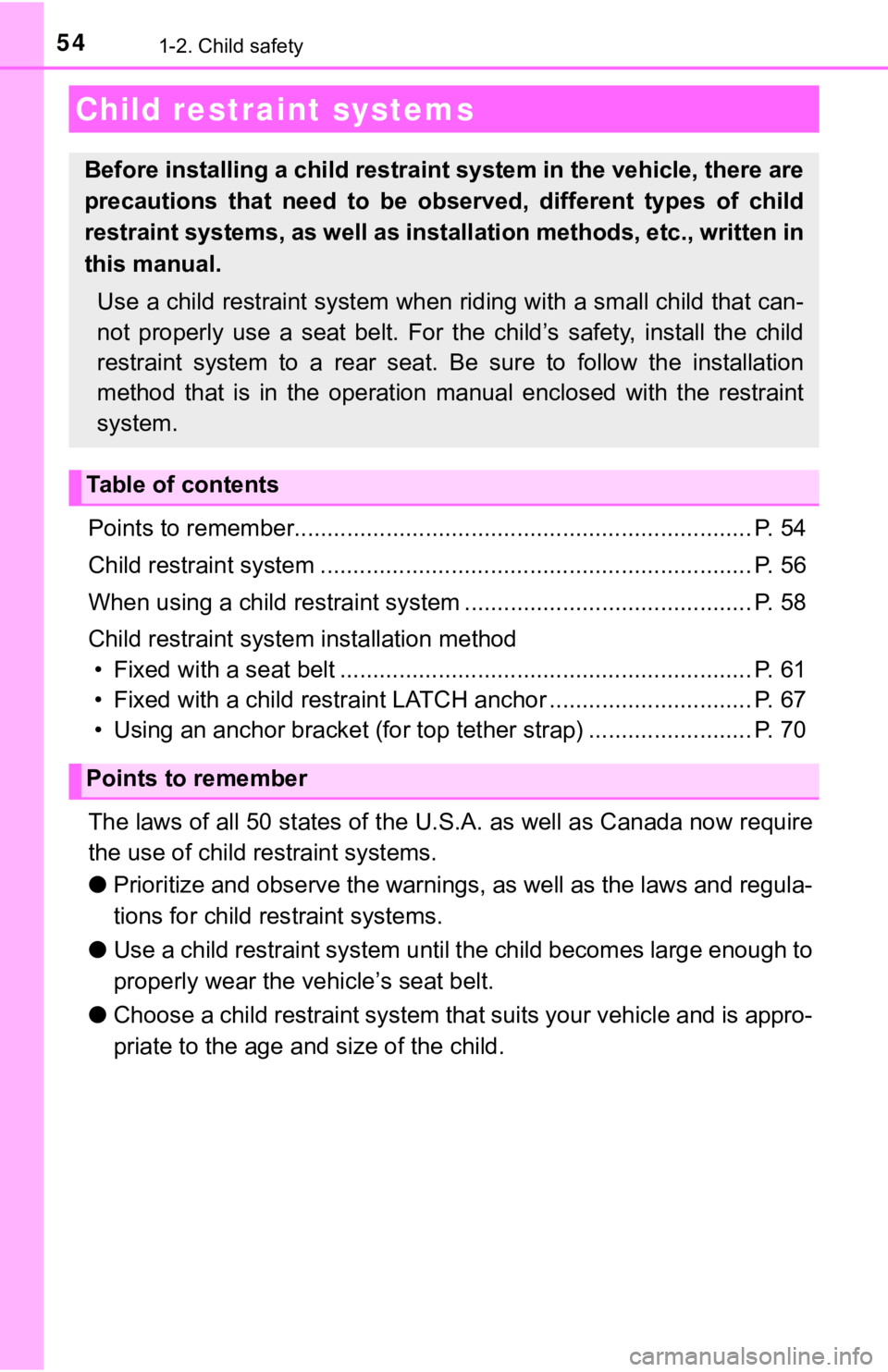
541-2. Child safety
Points to remember...................................................................... P. 54
Child restraint system ......................................... ......................... P. 56
When using a child restraint system ............................ ................ P. 58
Child restraint system installation method • Fixed with a seat belt ........................................ ....................... P. 61
• Fixed with a child restraint LATCH anchor ..................... .......... P. 67
• Using an anchor bracket (for t op tether strap) ......................... P. 70
The laws of all 50 states of the U.S.A. as well as Canada now r equire
the use of child r estraint systems.
● Prioritize and observe the warnings, as well as the laws and re gula-
tions for child res traint systems.
● Use a child restraint system u ntil the child becomes large enou gh to
properly wear the vehicle’s seat belt.
● Choose a child restraint system that suits your vehicle and is appro-
priate to the age and size of the child.
Child restraint systems
Before installing a child restraint system in the vehicle, ther e are
precautions that need to be observed, different types of child
restraint systems, as well as in stallation methods, etc., written in
this manual.
Use a child restraint system when riding with a small child tha t can-
not properly use a seat belt. For the child’s safety, install the child
restraint system to a rear seat. Be sure to follow the installa tion
method that is in the operation manual enclosed with the restra int
system.
Table of contents
Points to remember
Page 55 of 624
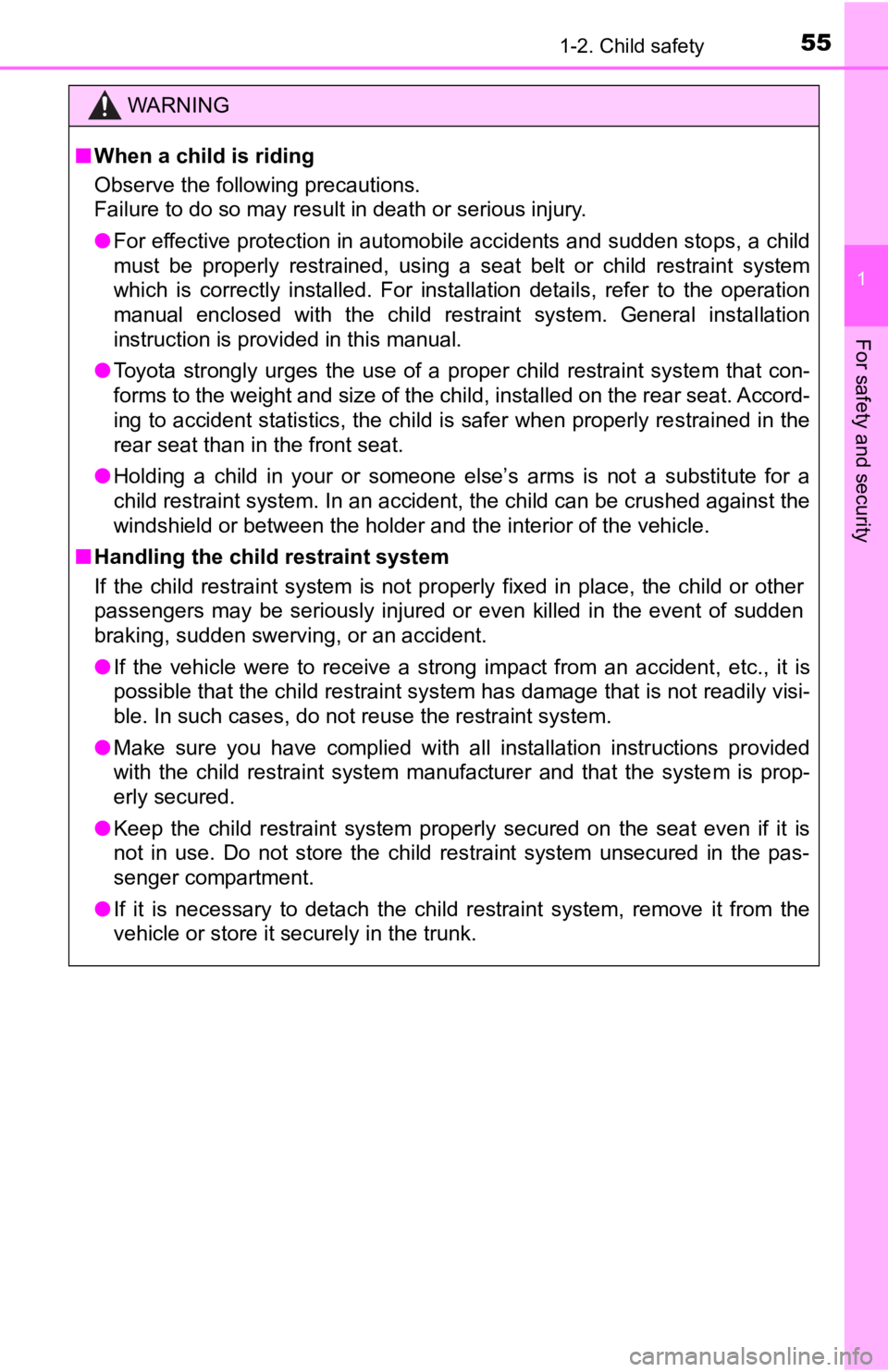
551-2. Child safety
1
For safety and security
WARNING
■When a child is riding
Observe the following precautions.
Failure to do so may result in death or serious injury.
● For effective protection in automobile accidents and sudden stops, a child
must be properly restrained, using a seat belt or child restrai nt system
which is correctly installed. For installation details, refer t o the operation
manual enclosed with the child restraint system. General installation
instruction is provided in this manual.
● Toyota strongly urges the use of a proper child restraint system that con-
forms to the weight and size of the child, installed on the rea r seat. Accord-
ing to accident statistics, the child is safer when properly restrained in the
rear seat than in the front seat.
● Holding a child in your or someone else’s arms is not a substit ute for a
child restraint system. In an accident, the child can be crushed against the
windshield or between the holder and the interior of the vehicle.
■ Handling the child restraint system
If the child restraint system is not properly fixed in place, t he child or other
passengers may be seriously injured or even killed in the event of sudden
braking, sudden swerving, or an accident.
● If the vehicle were to receive a strong impact from an accident , etc., it is
possible that the child restraint system has damage that is not readily visi-
ble. In such cases, do not reuse the restraint system.
● Make sure you have complied with all installation instructions provided
with the child restraint system manufacturer and that the syste m is prop-
erly secured.
● Keep the child restraint system properly secured on the seat even if it is
not in use. Do not store the child restraint system unsecured in the pas-
senger compartment.
● If it is necessary to detach the child restraint system, remove it from the
vehicle or store it securely in the trunk.
Page 56 of 624
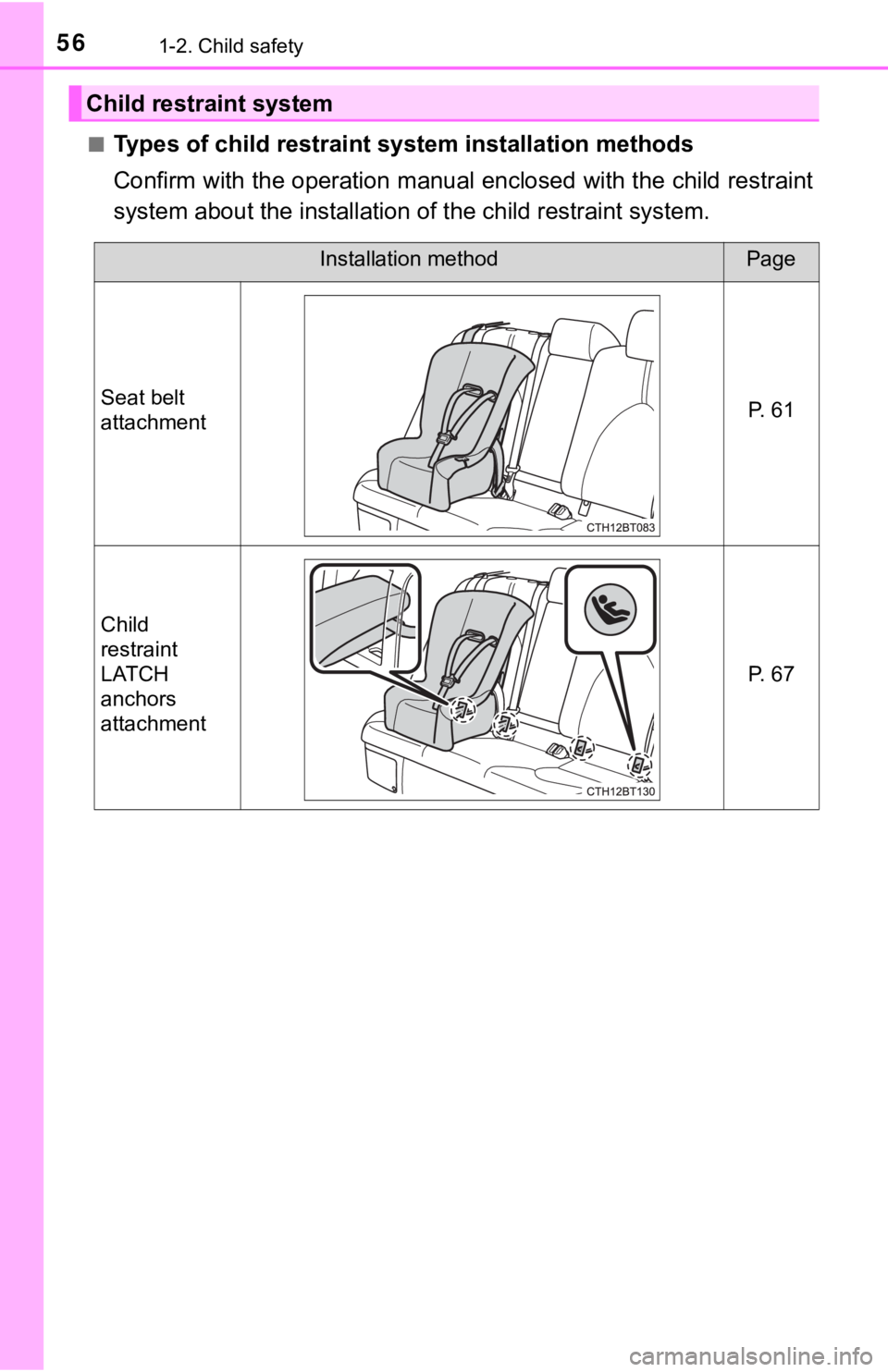
561-2. Child safety
■Types of child restraint system installation methods
Confirm with the operation manual enclosed with the child restr aint
system about the installation of the child restraint system.
Child restraint system
Installation methodPage
Seat belt
attachment P. 6 1
Child
restraint
LATCH
anchors
attachment P. 6 7
Page 57 of 624
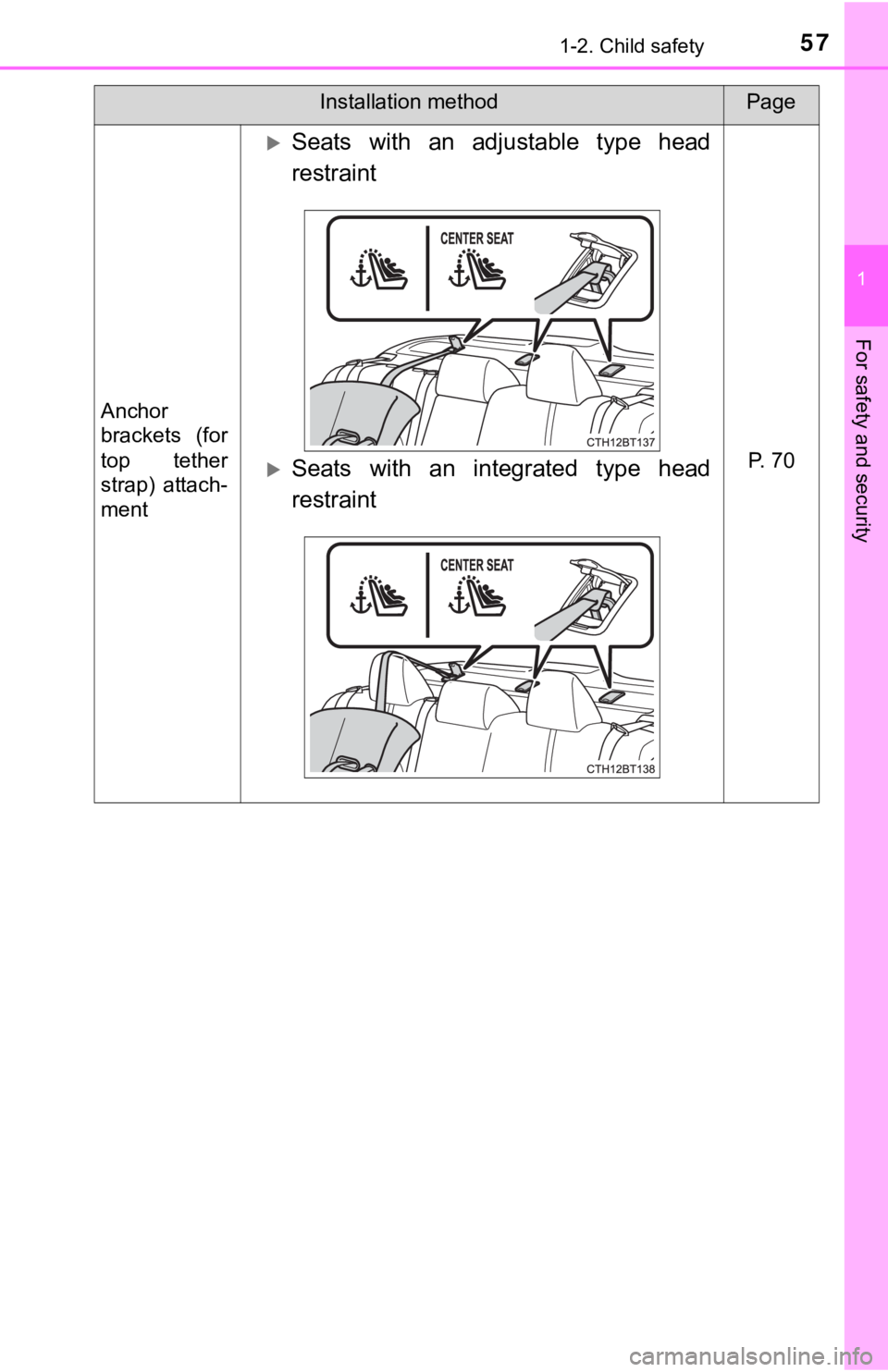
571-2. Child safety
1
For safety and security
Anchor
brackets (for
top tether
strap) attach-
ment
Seats with an adjustable type head
restraint
Seats with an integrated type head
restraintP. 7 0
Installation methodPage
Page 58 of 624
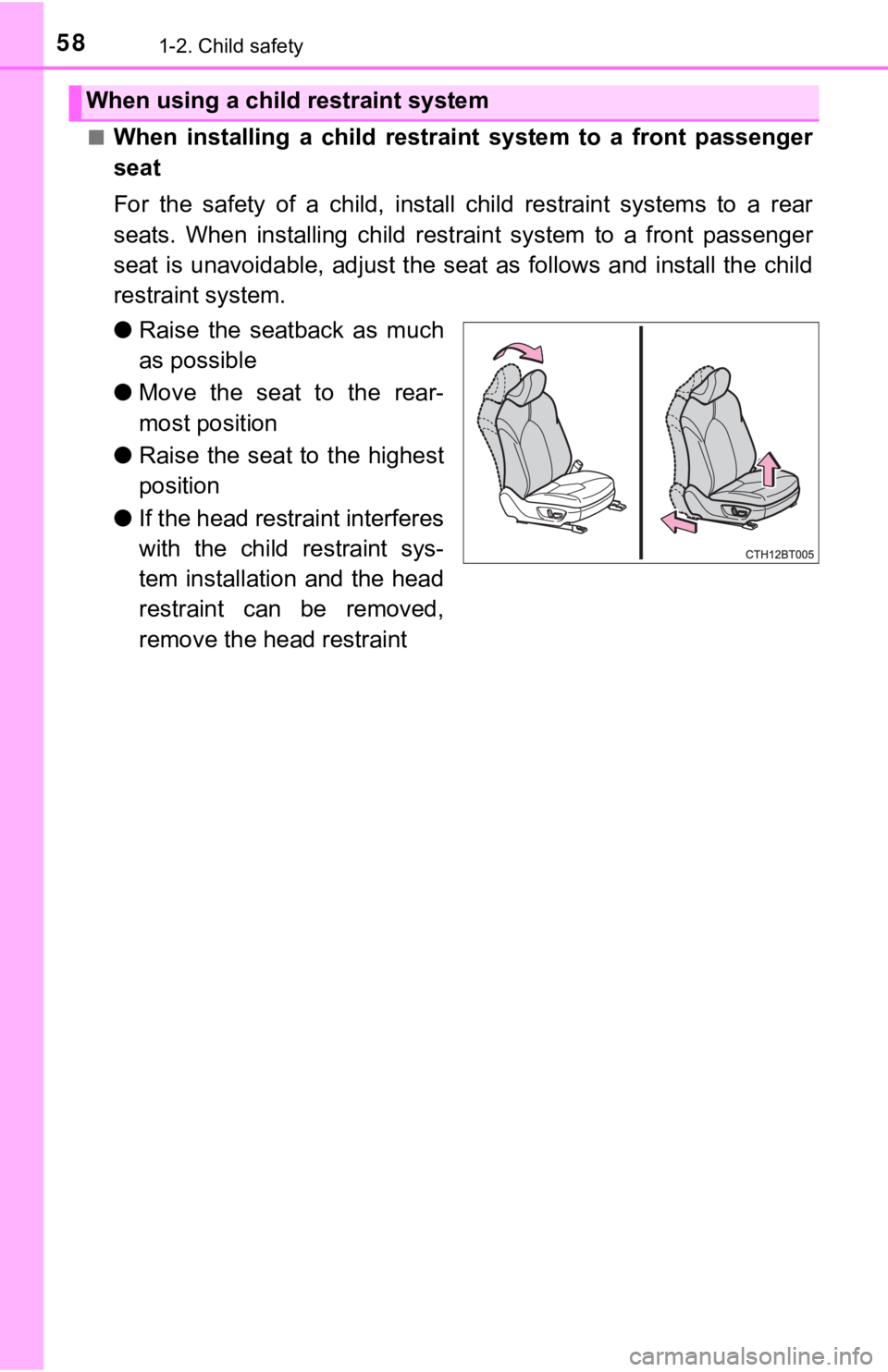
581-2. Child safety
■When installing a child restraint system to a front passenger
seat
For the safety of a child, install child restraint systems to a rear
seats. When installing child rest raint system to a front passenger
seat is unavoidable, adj ust the seat as follows and install the child
restraint system.
● Raise the seatback as much
as possible
● Move the seat to the rear-
most position
● Raise the seat to the highest
position
● If the head restraint interferes
with the child restraint sys-
tem installation and the head
restraint can be removed,
remove the head restraint
When using a child restraint system
Page 59 of 624
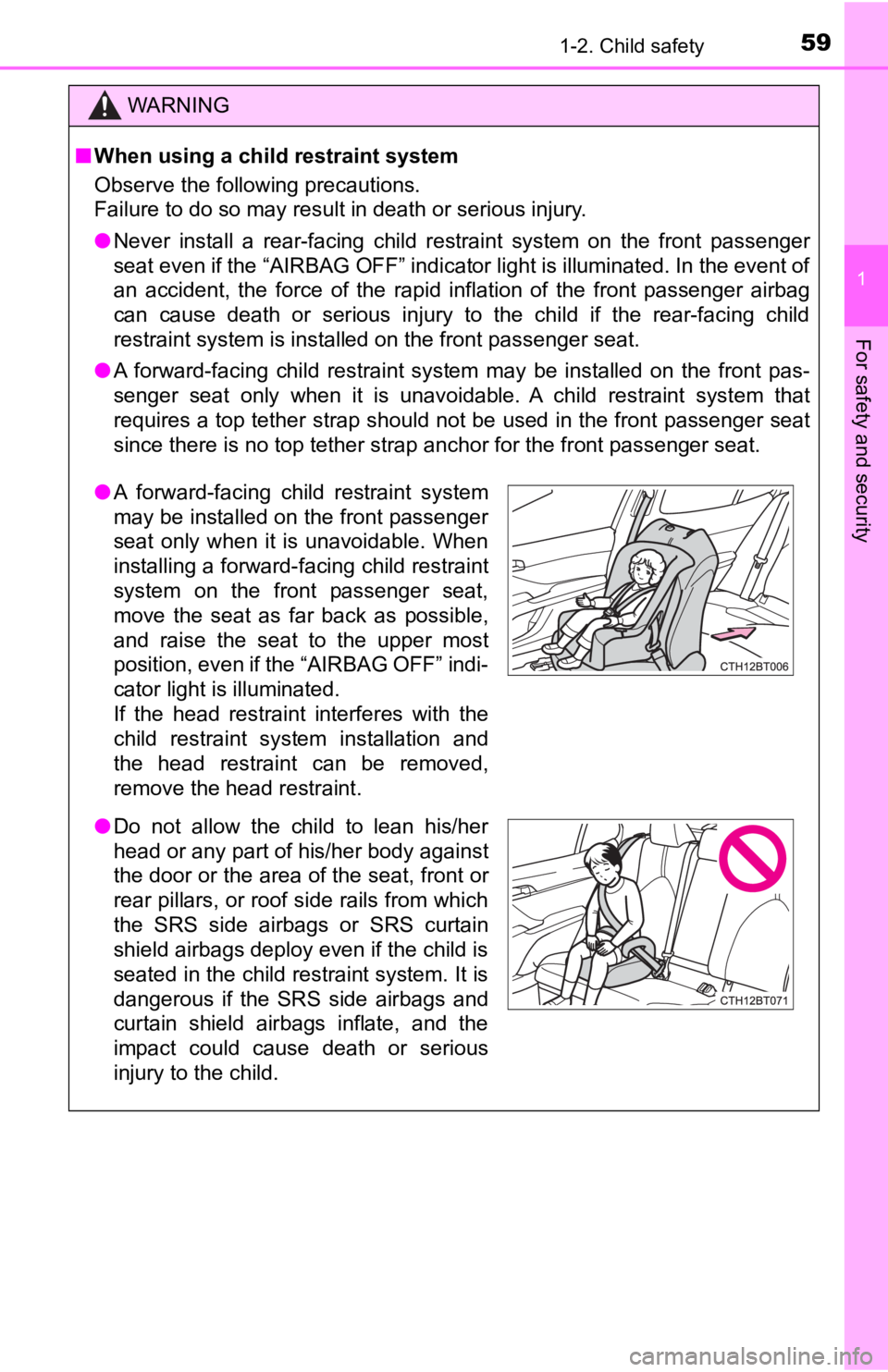
591-2. Child safety
1
For safety and security
WARNING
■When using a child restraint system
Observe the following precautions.
Failure to do so may result in death or serious injury.
● Never install a rear-facing child restraint system on the front passenger
seat even if the “AIRBAG OFF” indicator light is illuminated. In the event of
an accident, the force of the rapid inflation of the front passenger airbag
can cause death or serious injury to the child if the rear-facing child
restraint system is installed on the front passenger seat.
● A forward-facing child restraint system may be installed on the front pas-
senger seat only when it is unavoidable. A child restraint syst em that
requires a top tether strap should not be used in the front passenger seat
since there is no top tether strap anchor for the front passenger seat.
● A forward-facing child restraint system
may be installed on the front passenger
seat only when it is unavoidable. When
installing a forward-facing child restraint
system on the front passenger seat,
move the seat as far back as possible,
and raise the seat to the upper most
position, even if the “AIRBAG OFF” indi-
cator light is illuminated.
If the head restraint interferes with the
child restraint system installation and
the head restraint can be removed,
remove the head restraint.
● Do not allow the child to lean his/her
head or any part of his/her body against
the door or the area of the seat, front or
rear pillars, or roof side rails from which
the SRS side airbags or SRS curtain
shield airbags deploy even if the child is
seated in the child restraint system. It is
dangerous if the SRS side airbags and
curtain shield airbags inflate, and the
impact could cause death or serious
injury to the child.
Page 60 of 624
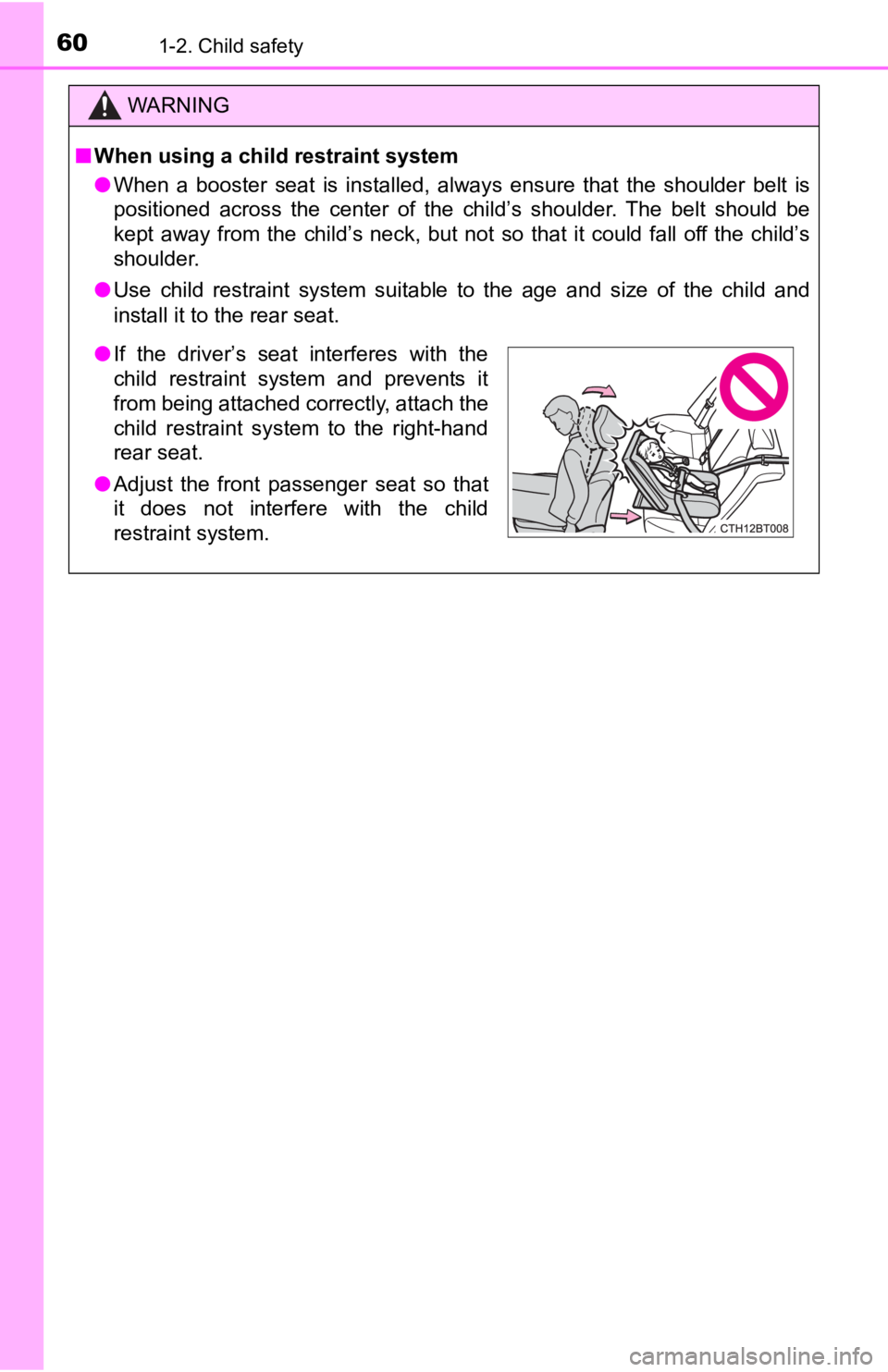
601-2. Child safety
WARNING
■When using a child restraint system
● When a booster seat is installed, always ensure that the should er belt is
positioned across the center of the child’s shoulder. The belt should be
kept away from the child’s neck, but not so that it could fall off the child’s
shoulder.
● Use child restraint system suitable to the age and size of the child and
install it to the rear seat.
●If the driver’s seat interferes with the
child restraint system and prevents it
from being attached correctly, attach the
child restraint system to the right-hand
rear seat.
● Adjust the front passenger seat so that
it does not interfere with the child
restraint system.